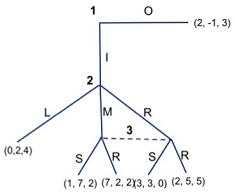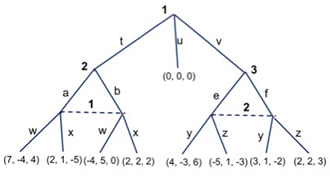Calculate and draw the best response function for firm Macroeconomics
Q1. In an industry, there are only two firms. They are producing identical products that compete in a market by choosing their quantities q1 and q2. The demand for the product is given by P = 600 – 10Q, where P denotes the market price, Q denotes the total quantity in the market. Both firms have the same marginal cost of MC = 60 and there are 2 periods. In the first period firm] chooses its quantity q1. In the second period, after observing firm 1’s quantity q1, firm2 chooses its quantity q2.
a. Calculate and draw the best response function for firm2.
b. What are the equilibrium quantities and profit for each firm?
2. Player1 and 2 bargain over how to split $8. Players alternate in making offers. Each offer is one period and players are impatient with a per period discount rate of δ = 0.5. First player1 makes a proposal that player2 accept or reject. If player2 rejects, then player2 makes a proposal that player1 can accept or reject. If played rejects, player1 gets 25% of what’s left (i.e. the total sum of money left at the 3rd period) while player2 gets 75%.
a. What’s the total sum of money at the 2nd period and the 3rd period?
b. What’s the backward induction outcome? (Please list steps of how you get the outcome.)
c. What’s the backward induction strategy profile?
Q3. In the following extensive-form game,
a. How many information sets does player2 have? Please specify whether each information set is singleton or non-singleton.
b. How many information sets does player3 have? Please specify whether each information set is singleton or non-singleton.
c. Is this game a complete information game or an incomplete information game?
d. Is this game a perfect information game or an imperfect information game?
e. How many subgames are there (including the whole game)? Please circle each subgame to indicate what it is.

Q4. In the following extensive-form game,
a. Specify player 1’s pure strategy set S1.
b. Specify player 2’s pure strategy set S2.
c. How many subgames are there (including the whole game)? Please circle each subgame to indicate what it is.
d. Solve for ALL the Subgame Perfect Nash Equilibrium of this game (Hint: use backwards induction method).

Q5. We twice-play the normal-form game below.
a. Please represent this game in an extensive-form representation.
b. How many information sets are there? Please circle each information set to indicate what it is.
| Player2 | |||
| C | D | ||
| Player1 | C | 3, 3 | 0, 4 |
| D | 4, 0 | 2, 2 | |
Q6. We twice-play the normal-form game below. What is the Nash Equilibrium?
| Player2 | ||||
| C | D | P | ||
| Player1 | C | 3, 3 | 0, 4 | -5, -5 |
| D | 4, 0 | 2, 2 | -5, -5 | |
| P | -5, -5 | -5, -5 | -10, -10 | |